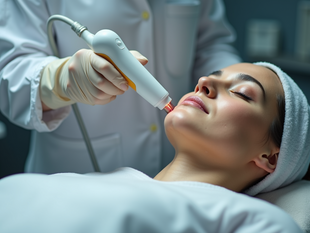
Understanding Excessive Sweating: A Comprehensive Guide
Sep 2
4 min read
0
2
0
What Is Excessive Sweating (Hyperhidrosis)?
Sweating is your body’s natural way of cooling down. However, in people with hyperhidrosis, the sweat glands are overactive. They produce more sweat than needed—even in cool weather or at rest.
Hyperhidrosis commonly affects:
Underarms (axillary hyperhidrosis)
Palms of the hands
Soles of the feet
Face and scalp
How Common Is It?
You’re not alone if you struggle with excessive sweating. Studies estimate that about 3–5% of the population suffers from hyperhidrosis. Many never seek treatment because they believe it’s just “normal sweating.”

Myths & Misconceptions
Myth vs. Fact: Sweating, Antiperspirants & Skin Health
Myth 1: Excessive sweating only happens in summer.
Fact: Hyperhidrosis can occur year-round, even in cool climates or air-conditioned rooms.
Myth 2: Excessive sweating means poor hygiene.
Fact: Hyperhidrosis is a medical condition. People with it often shower more frequently, yet still struggle with sweating.
Myth 3: Antiperspirants cure excessive sweating.
Fact: Antiperspirants only block sweat temporarily and may irritate skin. They don’t treat underlying hyperhidrosis.
Myth 4: Hidradenitis Suppurativa (HS) is caused by deodorants.
Fact: HS is not caused by poor hygiene or deodorants. Blocked sweat glands and skin irritation can worsen flare-ups in some individuals.
Myth 5: There’s nothing you can do about excessive sweating.
Fact: Safe and effective treatments—like botulinum toxin injections—can significantly reduce sweating and improve quality of life.
Causes of Excessive Sweating
There are two main types of hyperhidrosis:
Primary hyperhidrosis: Caused by overactive nerves that trigger sweat glands without a clear reason.
Secondary hyperhidrosis: Linked to medical conditions like diabetes, thyroid disorders, menopause, or certain medications.
Treatment Options
1. Medical-Grade Antiperspirants
These are stronger than over-the-counter products but may irritate sensitive skin.
2. Oral Medications
These can reduce sweating but may cause side effects such as dry mouth.
3. Iontophoresis
This device uses mild electrical currents to reduce sweating in hands or feet.
4. Botulinum Toxin Injections
A quick, minimally invasive treatment with proven results.
5. Surgery (in severe cases)
This is rarely required and only considered when other treatments fail.
Antiperspirants, Sweat Control & Hidradenitis Suppurativa
Many people turn to strong antiperspirants to control excessive sweating. While these can help in mild cases, they don’t always solve the problem. In some situations, they can even contribute to skin issues. Many clients don’t realize that overuse of antiperspirants or certain deodorants can play a role in skin irritation and conditions like hidradenitis suppurativa (HS).
How Antiperspirants Work
Antiperspirants contain aluminum-based compounds that temporarily block sweat ducts. This reduces the amount of sweat reaching the skin’s surface.
Potential Drawbacks
Prolonged or heavy use may cause skin irritation, itching, or rashes.
In some individuals, blocked sweat glands can trigger painful lumps or inflammation.
This can sometimes worsen or mimic hidradenitis suppurativa (HS), a chronic skin condition where sweat and oil gland blockages lead to painful nodules, abscesses, and scarring—most commonly in the underarms, groin, and other fold areas.
Important to Note
HS is not caused by deodorants or poor hygiene. However, irritation from blocked sweat glands may aggravate symptoms in those predisposed to it.
Switching to gentler, dermatologist-approved products may help reduce irritation.
For people with HS or severe sweating, medical treatments (such as botulinum toxin injections, prescription creams, or dermatology-led care) are usually more effective than relying on antiperspirants alone.
How Botulinum Toxin Works for Sweating
Botulinum toxin (commonly known by brand names like Botox®/ Azzulure) is not just for wrinkles. When injected into the skin, it blocks the chemical signals that activate sweat glands, reducing excessive sweating in targeted areas.
Benefits of Botulinum Toxin for Hyperhidrosis
Noticeable results within 3–7 days
Long-lasting effect (typically 6–9 months)
Quick procedure with minimal downtime
Safe and FDA-approved for underarm sweating (also widely used for hands, feet, and face)

Final Thoughts
Excessive sweating doesn’t have to control your daily life. Whether it’s stained clothes, damp handshakes, or discomfort at work, effective treatments are available. Botulinum toxin injections offer a safe, reliable, and minimally invasive solution to help you stay dry and confident year-round.
Frequently Asked Questions About Botulinum Toxin for Excessive Sweating
1. Is botulinum toxin safe for treating hyperhidrosis?
✅ Yes. Botulinum toxin is FDA-approved for underarm sweating and widely used by medical specialists for other areas like hands, feet, and face. When performed by trained professionals, it is a safe and effective treatment.
2. Does the treatment hurt?
Most clients describe the injections as quick and tolerable. Since ultra-fine needles are used, any discomfort is minimal. Numbing cream or ice can be applied for extra comfort if needed.
3. How soon will I see results?
Results typically begin within 3–7 days, with maximum effect seen after about 2 weeks.
4. How long do the results last?
On average, the effects last 6–9 months, after which maintenance sessions may be
required. Some people enjoy even longer-lasting relief.
5. Can botulinum toxin be used for sweating in areas other than the underarms?
Yes! It is effective for the palms, soles of the feet, and even the scalp. Your specialist will recommend the best treatment plan depending on the area and severity.
6. Are there any side effects?
Side effects are generally mild and temporary, such as slight bruising or tenderness at the injection site. Rarely, temporary muscle weakness may occur if treating the hands.
7. Who should avoid this treatment?
Botulinum toxin may not be suitable for pregnant or breastfeeding women, or individuals with certain neuromuscular disorders. Your doctor will review your medical history during consultation.
✨ Book a consultation with our specialists to find out if this treatment is right for you or click below for more details.






